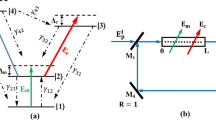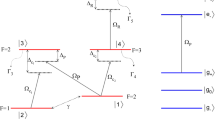Abstract
On the condition of strong electron–LO phonon coupling in an asymmetric quantum dot (QD), we study the eigenenergies and eigenfunctions of the ground and the first excited states under an applied electric field by using variational method of Pekar type. This QD system may be used as a two-level qubit. When the electron is in the superposition state of the ground and the first excited states, we obtain the time evolution of the electron probability density, which oscillates in the QD. It is found that due to the presence of the 3-D anisotropic harmonic potentials in the transverse and longitudinal directions of the QD, the electron probability density shows double-peak configuration, whereas there is only one peak if the confinement is 2-D symmetric in the x- and y-directions. The oscillation period is an increasing function of the transverse and longitudinal effective confinement lengths of the QD, and decreases with respect to the electron–phonon coupling strength and the electric field.




Similar content being viewed by others
References
Kamada, H., Gotoh, H.: Quantum computation with quantum dot excitons. Semicond. Sci. Technol. 19, S392–S396 (2004)
Li, S.S., Xia, J.B.: Effective-mass theory for coupled quantum dots grown on (11N)-oriented substrates. Chin. Phys. 16, 1–5 (2007)
Liu, Y.F., Xiao, J.L.: The effects of LO phonons on charge qubit. Phys. B 403, 3013–3017 (2008)
Sikorski, C., Merkt, U.: Spectroscopy of electronic states in InSb quantum dots. Phys. Rev. Lett. 62, 2164–2167 (1989)
Lorke, A., Kotthaus, J.P., Ploog, K.: Coupling of quantum dots on GaAs. Phys. Rev. Lett. 64, 2559–2562 (1990)
Normura, S., Kobayashi, T.: Exciton–LO–phonon couplings in spherical semiconductor microcrystallites. Phys. Rev. B 45, 1305–1316 (1992)
Li, S.S., Xia, J.B.: Electronic structure and binding energy of a hydrogenic impurity in a hierarchically self-assembled GaAs/\(\text{ Al }_{{\rm x}}\text{ Ga }_{1-{\rm x}}\) As quantum dot. J. Appl. Phys. 100, 083714 (2006)
Chi, F., Li, S.S.: Spin-polarized transport through an Aharonov–Bohm interferometer with Rashba spin-orbit interaction. J. Appl. Phys. 99, 043705 (2006)
Sun, J.K., Li, H.J., Xiao, J.L.: The temperature effect of the triangular bound potential quantum dot qubit. Superlatt. Microstruct. 46, 476–482 (2009)
Berman, G.P., Doolen, G.D., Tsifrinovich, V.I.: Solid-state quantum computation—a new direction for nanotechnology. Superlatt. Microstruct. 27, 89–104 (2000)
Barenco, A., Deutsch, D., Ekert, A., Jozsa, R.: Conditional quantum dynamics and logic gates. Phys. Rev. Lett. 74, 4083–4086 (1995)
Lis, S.S., Xia, J.B., Liu, J.L., Yang, F.H., Niu, Z.C., Feng, S.L., Zheng, H.Z.: InAs/GaAs single-electron quantum dot qubit. J. Appl. Phys. 90, 6151–6155 (2001)
Li, S.S., Long, G.L., Bai, F.S., Feng, S.L., Zheng, H.Z.: Quantum computing. Proc. Natl. Acad. Sci. USA 98, 11847–11848 (2001)
Chen, Y.J., Xiao, J.L.: Temperature effects of parabolic linear bound potential and Coulomb bound potential quantum dot qubit. Commun. Theor. Phys. 52, 601–605 (2009)
Loss, D., DiVincenzo, D.P.: Quantum computation with quantum dots. Phys. Rev. A 57, 120–126 (1998)
Xiao, J.L.: Influences of temperature and coulomb bound potential on the properties of quantum rod qubit. Superlatt. Microstruct. 60, 248–256 (2013)
Li, W.P., Yin, J.W., Yu, Y.F., Wang, Z.W., Xiao, J.L.: The effect of magnetic on the properties of a parabolic quantum dot qubit. J. Low. Temp. Phys. 160, 112–118 (2010)
Yin, J.W., Xiao, J.L., Yu, Y.F., Wang, Z.W.: The influence of electric field on a parabolic quantum dot qubit. Chin. Phys. B 18, 446–450 (2009)
Wang, Z.W., Xiao, J.L.: Parabolic linear bound potential quantum dot qubit and its optical phonon effect. Acta. Phys. Sin. 56, 678–682 (2007) (in Chinese)
Wang, Z.W., Li, W.P., Yin, J.W., Xiao, J.L.: Properties of parabolic linear bound potential and Coulomb bound potential quantum dot qubit. Commun. Theor. Phys. 49, 311–314 (2008)
Acknowledgments
This project was supported by the National Science Foundation of China under Grant No. 10964005.
Author information
Authors and Affiliations
Corresponding author
Rights and permissions
About this article
Cite this article
Xiao, JL. The effect of electric field on an asymmetric quantum dot qubit. Quantum Inf Process 12, 3707–3716 (2013). https://doi.org/10.1007/s11128-013-0631-8
Received:
Accepted:
Published:
Issue Date:
DOI: https://doi.org/10.1007/s11128-013-0631-8




